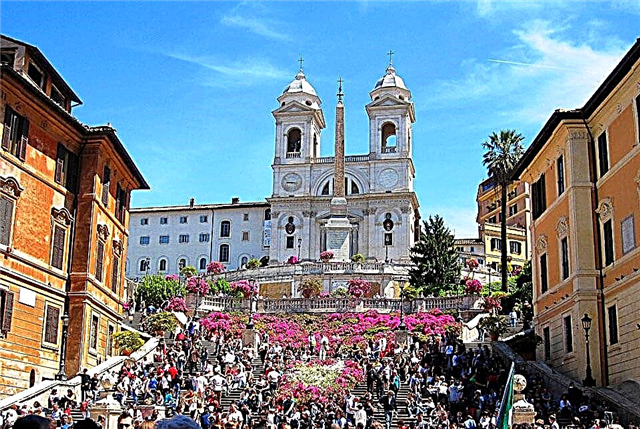Address: Russia, Nizhny Novgorod region, Nizhny Novgorod, Minin and Pozharsky square
Start of construction: 1508 year
Completion of construction: 1513 year
Number of towers: 13
Length of walls: 2080 m.
Coordinates: 56 ° 19'42.2 "N 44 ° 00'10.6" E
Cultural heritage site of the Russian Federation
Short description
At the confluence of the Volga and Oka rivers, at the top of a mountainous cape, there is a grandiose brick fortress with 12 towers - the Nizhny Novgorod Kremlin. Built in 1515, it was considered one of the most perfect structures of Russian military fortification architecture.
View of the Kremlin from Pochainskaya street
Over the centuries, the Nizhny Novgorod Kremlin has successfully performed two important functions - defensive and administrative. As a reliable shield, it protected the population from enemy raids and served as a meeting place for governing bodies.
Today, the Nizhny Novgorod Kremlin is the pride and decoration of the city, an open-air museum and a favorite place for walking. It is best to admire the panorama of the Kremlin from the water - from the deck of the ship.
Dmitrievskaya tower
Three rebirths of the Nizhny Novgorod Kremlin - from wood to brick
The Nizhny Novgorod Kremlin is the historical center of the city, the place where the history of Nizhny Novgorod originates.
The monument was transformed three times - it was made of wood, stone, and finally, 5 centuries ago, it appeared before the townspeople in a brick guise.
Koromyslov tower
The first chronicle mention of the Kremlin dates back to 1221, when the Grand Duke Yuri Vsevolodovich (nephew of Yuri Dolgoruky, the founder of Moscow) laid Novgorod, that is, a "new city", at the mouth of the Oka River, and surrounded it with a wooden and earthen fortress. In the 1370s, due to the growing influence of Nizhny Novgorod, which became the capital of the Grand Duchy, Prince Dmitry Konstantinovich attempted to build a stone citadel.
According to historians, some semblance of a stone Kremlin was erected, in the center of which was the Dmitrov Tower. At the beginning of the 16th century, when military conflicts escalated between the Russian state and the Kazan Khanate, stone fortifications were erected in order to strengthen the defense. The beginning of construction was marked by the construction of the Ivanovskaya tower in 1500, but the main work was carried out in a short time - from 1508 to 1515. under the leadership of a talented Italian military engineer and architect, who in Russia was called Peter Fryazin.
Ivanovskaya tower
The Nizhny Novgorod Kremlin became an important stronghold in the struggle against the Kazan Khanate. The 2-kilometer-long brick wall of the Kremlin was reinforced by 13 towers, 12 of them have survived to this day. Due to its high engineering and fortification characteristics and solid artillery weapons, the Nizhny Novgorod Kremlin withstood repeated sieges and shelling and was never taken by storm. In the 1550s. after the annexation of Kazan to the Moscow state, the “stone city” lost its defensive significance, and later the Kremlin towers were used for the needs of various government institutions and warehouses.
Legends of the Nizhny Novgorod Kremlin - robbers, victims and treasures
Taynitskaya tower
One of the legends says that when the Grand Duke of Moscow Ivan III decided to build a stone Kremlin, robbers languished in Nizhny Novgorod prisons. Their chieftain, Danilo Volkhovets, was a jack of all trades: he could forge a blade, make a bell, build a white stone palace, and repair a ship. The robbers spent a year in the dungeon, but on one sunny day the doors opened and the guards took the criminals to work. Good fellows-daredevils hewed stones, dragged bricks, dug deep ditches.
And the robbers were so clever in their work that the governor of Volynets, upon completion of construction, decided to release them all free. However, the work progressed slowly, and Vasily III hired the Italian master Petruja Francesco and his assistant Giovanni Tatti. In Petra, the townspeople immediately saw a talented person, and his assistant did not understand serfdom and was known as a fighter and a bully, he himself asked for quarrels.
From left to right: Koromyslova Tower, Nikolskaya Tower
For his tricks, the Russians changed the Italian name - Giovanni Tatti - in their own way and nicknamed the assistant Chevy Tate. Another legend explains the origin of the name of the Rocker Tower. Once enemy scouts tried to take possession of the "stone city", but on the way they met a girl who at dawn went to the river to fetch water. She began to defend herself with a yoke and killed a dozen enemies. The scouts marveled at the woman's courage and retreated. Another version of the same legend says that the construction of the Nizhny Novgorod Kremlin began with the Koromyslovaya Tower, and according to the ancient belief, at the time of laying the first stones, a living creature had to be sacrificed, which would be the first to appear in this place. A girl with buckets on a yoke passed by.
On the wall of the Nizhny Novgorod Kremlin
This girl was walled up in the base of the wall. But the main secrets of the Nizhny Novgorod Kremlin are hidden deep underground. According to legend, in the bowels of the fortress lies the library of Ivan the Terrible, brought from Byzantium by Sophia Palaeologus, the wife of Ivan III... The treasure has not yet been found.
Attraction rating:
Scheme of the Nizhny Novgorod Kremlin












